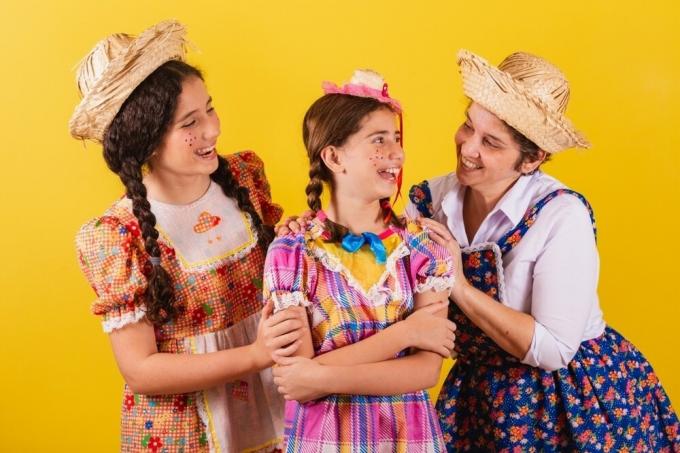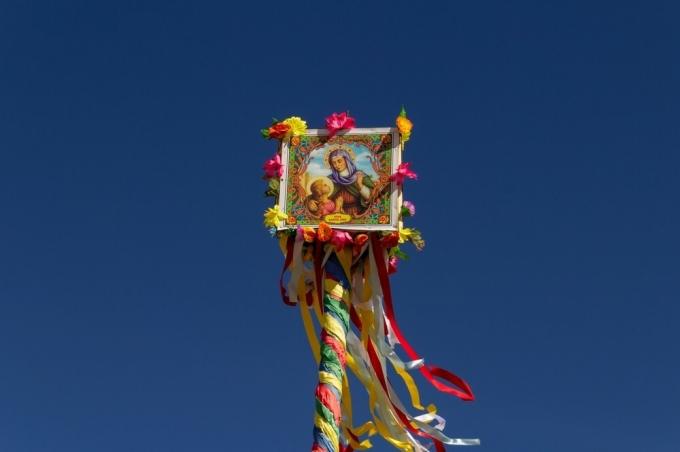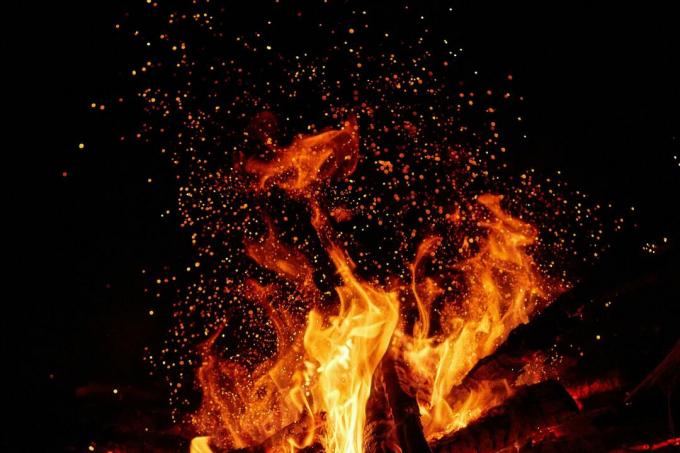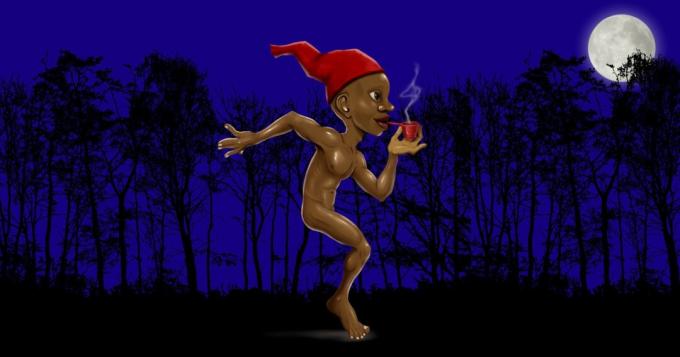June festivals are celebrations that take place every year in month of June.
They are traditional throughout Brazil, especially in the Northeast region.
These are festivities that commemorate the saints of the June season: Santo Antônio on June 13th, São João, June 24th, and São Pedro, June 29th.
It is common for June festivities to also be called festivities of Saint John or even of camp.
In Brazilian festivals, square dancing is performed, places are decorated with flags and balloons, checkered or "caipira" clothes are worn, and food derived from corn and cassava is eaten.
Despite having a Christian influence, June celebrations have a pagan origin. They are related to the summer solstice celebrations, in the northern hemisphere, and winter solstice, in the southern hemisphere.
Features of the Festa Junina
The Brazilian June festivities have slight variations according to the region, but the common characteristics are many and are present in celebrations throughout the country. Are they:
Flags and balloons

The decoration of the June parties are made with colorful flags, balloons and checkered fabrics. this kind of decoration brought to Brazil by the Portuguese.
Even today, the feasts of popular saints, as the June festivities are called in Portugal, still use a similar decoration.
June party foods

Even though it has European origins, with many elements from Portuguese festivals, the Brazilian June Festival is multicultural. Indigenous and African cultures are very present in typical foods.
It is common throughout Brazil to eat dishes derived from corn and cassava. Among them are fried manioc (cassava), boiled corn, pamonha, corn and cassava cakes, and canjica (corn porridge).
Desserts are pé-de-moleque, paçoca, and rapadura. It is also very common to drink warm. The drink is made with cachaça or wine, cinnamon and sugar; and gets its name because it is served very hot, relieving the winter cold.
Gang

Quadrilha is a European dance, originated in England. It was brought to Brazil by the Portuguese court during the stay of the royal family in the country.
Despite its noble origin, it became popular among the common people and began to be danced at parties dedicated to the saints of the month of June.
With the popularization, changes happened. The dance began to be performed with colorful clothes and faster rhythms. Musicality, on the other hand, incorporated common instruments, such as the concertina and the triangle.
the gang is danced in pairs and there is a master of ceremonies, who leads the steps performed by the dancers.
redneck costumes

The costumes used in the June festivities are caricatured, trying to imitate what would be the rustic way of dressing, since the June festivities were celebrated mainly in the interior of Brazil.
However, the country way of dressing is inspired by the clothes worn by the nobility. Like the quadrille, the clothes used in the São João festivities are modeled on court costumes.
The people tried to keep up with fashion, but the luxury of costumes was not within reach of the common population. So voluminous dresses were made, but with colorful and cheap fabrics (like calico), while men's hats had as their main material the straw.
Currently, to further characterize the rustic costumes, people also use checkered fabrics, paint their faces with mustaches, beards and freckles, in addition to tying their hair in pigtails.
Mast of Saint John

Having a pole in honor of São João and other saints of the June season is a tradition. This custom is related to European pagan rituals, which were later incorporated by the Catholic Church.
The pole usually has a lot of colorful ornaments and on its top is the flag with the image of Saint John. Many masts, in addition to the figure of Saint John, also feature images of Saint Anthony, Saint Peter or a popular local saint.
Bonfire

The bonfire of the June festivals also has a pagan origin. At summer solstice celebrations in Europe, bonfires were lit to ward off evil spirits from harvest celebrations.
At the Brazilian party, the bonfire ended up becoming a method of warming up the winter nights. Games, such as jumping over the bonfire, were also performed, but they are not recommended, as they are dangerous.
Today, both bonfires and hot air balloons must not be used in the June festivities (and other celebrations).
Typical party games

It is common for the festivals of São João to have typical games. There are a variety of them, but the most popular ones are: elegant mail, fishing, chain and target shooting.
The most traditional of June party games is the wedding in the countryside. It is a performance, usually performed during a quadrille.
The plot of the wedding story may vary, but the ever-present characters are the bride and groom, the bride's parents and the priest. A country wedding is a fun and funny moment, often impromptu.
June party music

The songs heard and danced at the June festivities are commonly from the interior of the country, especially from the northeast region. They are songs that tell the happiness of the party, the daily life of the caipira, the reality of the drought and the joy of the arrival of the rain, or even talk about migration and love.
There are also the cantigas de São João, songs with simple and easy-to-learn verses. They usually sing the party traditions, such as fall, fall, balloon or melon chapel.
The traditional musical instruments of the June festivities are the concertina, O triangle, The zabumba, The viola and the rattle.
Festa Junina in Brazil

Festas Juninas are one of the biggest festivities in Brazil. He has European origin and arrived in Brazil with the Portuguese colonizers.
also have influence of indigenous and African cultures, present mainly in the interior of the country. Typical foods and musicality are examples of this presence.
The June festivities best known for their dimension and tradition are those of Campina Grande, in Paraíba, and Caruaru, in Pernambuco.
Another festivity that marks the period of Brazilian June festivities is the bumba-meu-boi. The party takes place in several states, with emphasis on Maranhão and Amazonas (where it is called ox-bumbá).
The celebrations commemorate a popular tale, of oral tradition, which addresses the story of a couple of enslaved people who live in the northeastern hinterland. The pregnant woman has a desire to eat beef tongue. To satisfy his wife's hunger, the husband kills the farm's ox to prepare the tongue.
The owner of the farm learns of the death of his ox and goes in search of the couple to punish him. The couple manages to resuscitate the ox and, in celebration, a big party is given.
History may change from region to region of Brazil. In the Amazon festival, for example, there is a presentation by the pajé (a figure from indigenous culture). However, the main plot, of the pregnant wife craving ox tongue and the feast of the animal's resurrection are always maintained.
Learn more about Brazilian folklore and the Brazilian culture.
Origin of Festa Junina
The feasts of São João, although today they are named after a saint, originate from the european pagan holidays, related to the celebrations for the good harvest and the summer solstice.
Some of the characteristics of the festival still date back to this period, such as the presence of bonfire It's from mast (later called the St. John's mast).
Indigenous peoples in South America also used to celebrate the solstice period, but in winter. In the celebration, like the Europeans, they celebrated the good harvest.
Solstice festivities had a strong popular appeal and were incorporated by Christianity, especially by the Catholic Church, with the aim of give a Christian religious character to the party.
The festivities then began to be related to the saints of the month of June, Santo Antônio, São João and São Pedro. São João being the most popular saint, even receiving the name of the party in Brazil.
Solstice celebrations are still celebrated in many places around the world. In Nordic and Scandinavian countries, for example, they receive names that vary from the term "midsommar", which means "midsummer".
Saint John's Day, June 24th, is usually the summer and winter solstice, in the northern and southern hemispheres, respectively.
See also what is Summer Solstice It is Winter Solstice.


